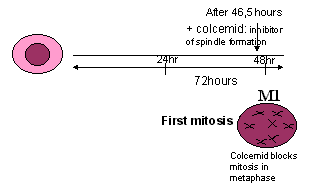
Structural chromosome aberrations may be induced via DNA breaks by various types of mutagens. Such DNA breaks may either rejoin such that the chromosome is restored to its original state, rejoin incorrectly or not rejoin at all. These last two cases may be observable on microscopic preparations of metaphase cells. Many of these gross changes probably will not allow cell survival after division, however they serve as indicators for the induction of smaller, not readily observable changes, which do allow cell survival but may have deleterious consequences for the organism.
The chromosome aberration test is most often performed on human peripheral blood lymphocytes. As peripheral lymphocytes are in the resting G0 stage of the cell cycle, they have to be stimulated to divide by an aspecific antigen, like phytohaemagglutinin. After 46,5 hours just before fixation (at 48 hours) a spindle inhibitor like colcemid is added to block the cells in the (pro)metaphase of the first mitosis.

Induced chromosomal aberrations can be divided into two main classes: chromosome-type aberrations, involving both chromatids of a chromosome, and chromatid-type aberrations involving only one of the two chromatids. Ionizing radiation induces chromosome-type aberrations (symmetric aberrations), like dicentrics, inversions, ring chromosomes, in the G0 or G1 stage of the cell cycle (i.e. prior to replication), while chromatid type aberrations (asymmetric aberrations), like breaks and gaps, are produced during the S or G2 stage (i.e. during or after replication). Most chemical mutagens are S-dependent clastogens and therefore produce chromatid-type aberrations.
Several types of aberrations can be distinguished:
Structural aberrations:
gaps
breaks
dicentric chromosomes
ring chromosomes
Numerical aberrations: (not adequate because of technical artefacts with spreading)
polyploidy (4n)
hypodiploidy (< 46chr)
hyperdiploidy (> 46chr)
Characteristics of CA test:
Biomarker of effect: highly relevant for cancer risk assessment
End-point: chromosome (and genome) mutations
Discrimination between chromatid type aberrations, chromosome type aberrations
Advantages/ Disadvantages
|
Advantages |
Disadvantages |
|
|
Confounding factors:
smoking
age